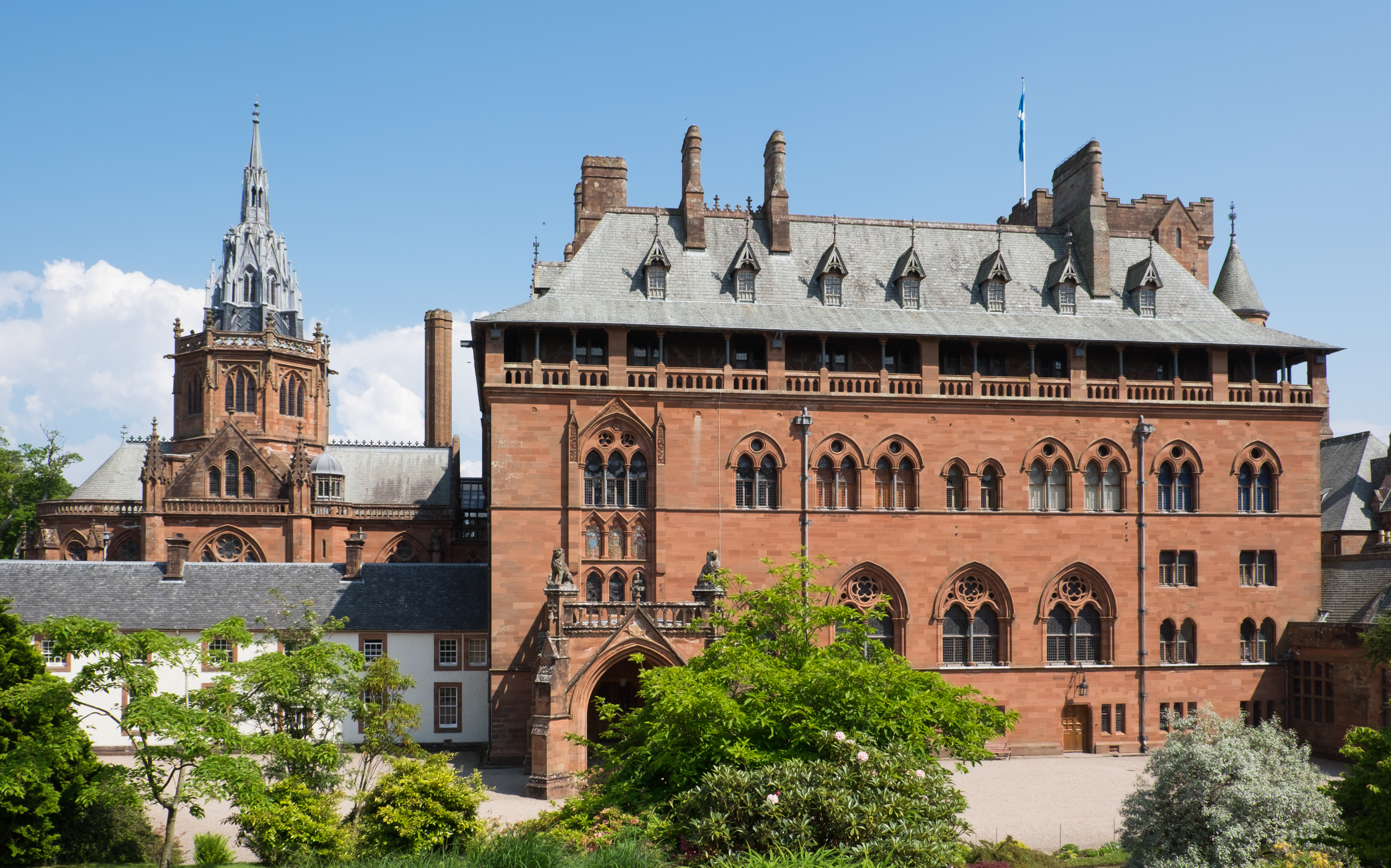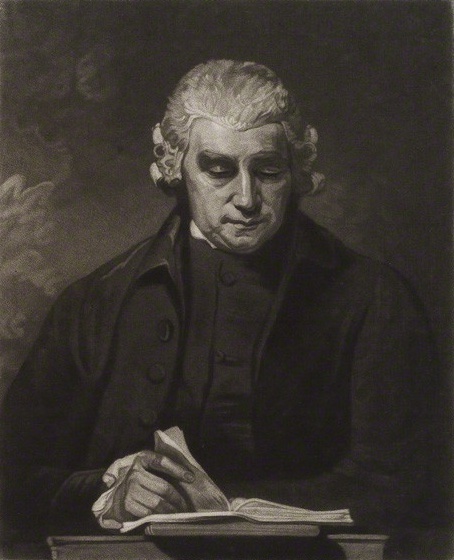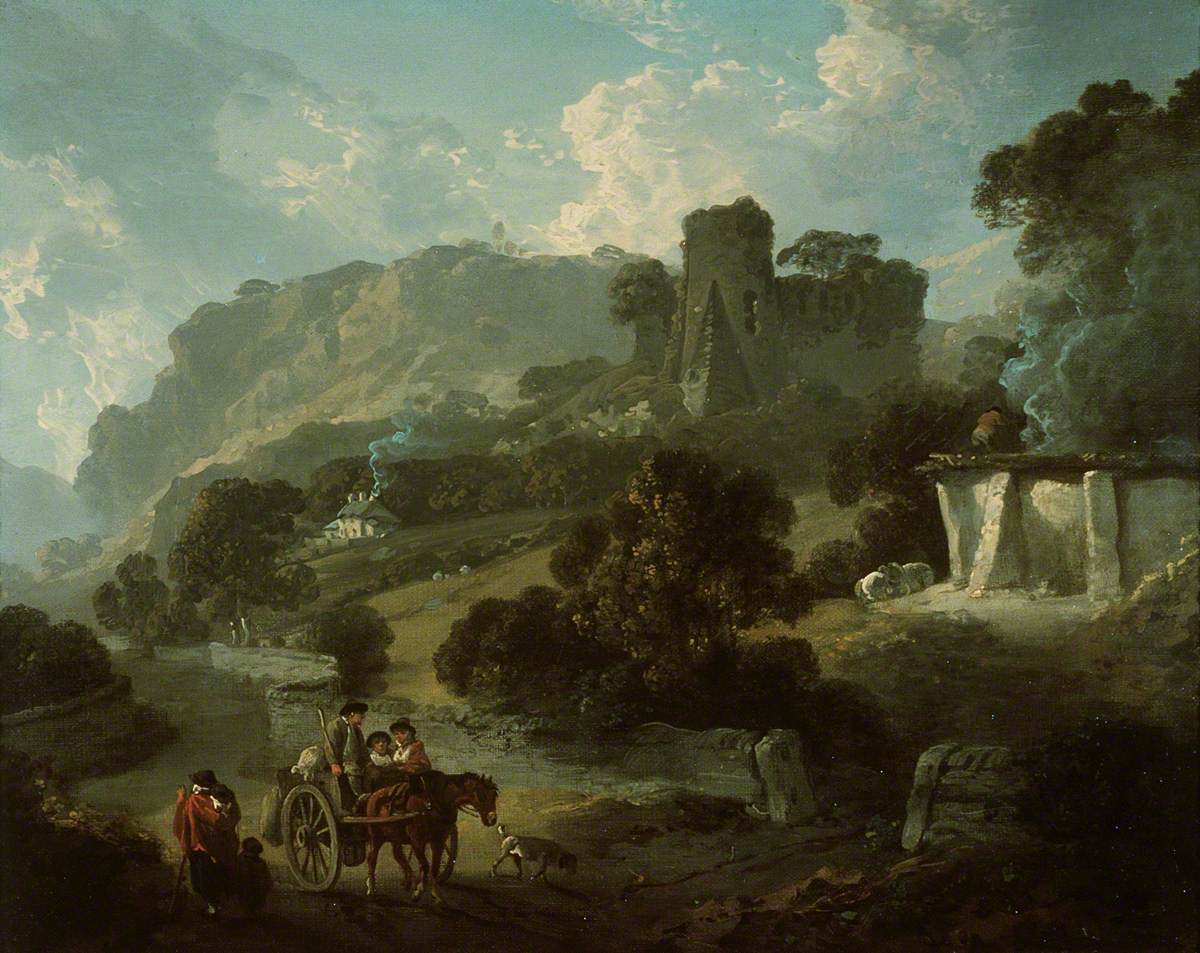|
Mount Stuart House
Mount Stuart House, on the east coast of the Isle of Bute, Scotland, is a country house built in the Gothic Revival style and the ancestral home of the Marquesses of Bute. It was designed by Sir Robert Rowand Anderson for the 3rd Marquess in the late 1870s, replacing an earlier house by Alexander McGill, which burnt down in 1877. The house is a Category A listed building. Background The house is the seat of the Stuarts of Bute, derived from the hereditary office "Steward of Bute" held since 1157. The family are direct male-line descendants of John Stewart, the illegitimate son of King Robert II of Scotland, the first Stuart King, by his mistress, Moira Leitch. By virtue of this descent, they are also descendants of Robert the Bruce, whose daughter Marjorie was mother of Robert II by her marriage to Walter Stewart, 6th High Steward of Scotland. History The original house was built in 1719 for The 2nd Earl of Bute, but was rebuilt for The 3rd Marquess of Bute following ... [...More Info...] [...Related Items...] OR: [Wikipedia] [Google] [Baidu] |
Rothesay, Bute
Rothesay ( ; gd, Baile Bhòid ) is the principal town on the Isle of Bute, in the council area of Argyll and Bute, Scotland. It lies along the coast of the Firth of Clyde. It can be reached by ferry from Wemyss Bay, which offers an onward rail link to Glasgow. At the centre of the town is the 13th-century ruin Rothesay Castle, unique in Scotland for its circular plan. Etymology In modern Scottish Gaelic, Rothesay is known as , meaning 'town of Bute'. The English-language name, which was written as ''Rothersay'' in 1321, ''Rosay'' around 1400, and ''Rothissaye'' around 1500, originally referred to the castle. Since the castle was surrounded by a moat connected to the sea, the name may have originally meant 'Rother's Isle' (the Old Norse suffix means "isle"), or it may be an alteration of the Gaelic word , meaning 'fort'. History The old town centred on Rothesay Castle, which was built in the 13th century. The castle has long stood in ruins, but it is nevertheless picturesque ... [...More Info...] [...Related Items...] OR: [Wikipedia] [Google] [Baidu] |
Walter Stewart, 6th High Steward Of Scotland
Walter Stewart (G. W. S. Barrow, ‘Stewart family (per. c.1110–c.1350)’, ''Oxford Dictionary of National Biography'', Oxford University Press, 2004.9 April 1327) was the 6th Hereditary High Steward of Scotland and was the father of King Robert II of Scotland, the first Stewart monarch. Origins He was born at Bathgate Castle, West Lothian, Scotland, the eldest son and heir of James Stewart, 5th High Steward of Scotland (c.1260-1309) by his third wife Giles (Latinised to ''Egidia'') de Burgh, a daughter of the Irish nobleman Walter de Burgh, 1st Earl of Ulster. Career At the age of 21 Walter fought against the English at the Battle of Bannockburn in 1314Simpson, David, ''The Genealogical and Chronological History of the Stuarts'', Edinburgh, 1713. where according to some sources, together with Douglas he commanded the left wing of the Scots' army,Anderson, William, ''The Scottish Nation'', Edinburgh, 1867, vol.ix, p. 513, states he was 21 years of age at Bannockburn. but acc ... [...More Info...] [...Related Items...] OR: [Wikipedia] [Google] [Baidu] |
Listed Houses In Scotland
{{disambig ...
Listed may refer to: * Listed, Bornholm, a fishing village on the Danish island of Bornholm * Listed (MMM program), a television show on MuchMoreMusic * Endangered species in biology * Listed building, in architecture, designation of a historically significant structure * Listed company, see listing (finance), a public company whose shares are traded e.g. on a stock exchange * UL Listed, a certification mark * A category of Group races in horse racing See also * Listing (other) Listing may refer to: * Enumeration of a set of items in the form of a list * Johann Benedict Listing (1808–1882), German mathematician. * Listing (computer), a computer code listing. * Listing (finance), the placing of a company's shares on the l ... [...More Info...] [...Related Items...] OR: [Wikipedia] [Google] [Baidu] |
Isaac Reed
Isaac Reed (1 January 1742 – 5 January 1807) was an English Shakespearean editor. Biography The son of a baker, he was born in London. He was articled to a solicitor, and eventually set up as a conveyancer at Staple Inn, where he had a large practice. His major work was the ''Biographia dramatica'' (2 vols., 1782), a set of biographies of dramatists and a descriptive dictionary of their plays. This book, which was an enlargement of David Erskine Baker's ''Companion to the Playhouse'' (2 vols., 1764), was re-edited (3 vols.) by Stephen Jones in 1811. The original work by Baker had been based on Gerard Langbaine's ''Account of the English Dramatick Poets'' (1691), Giles Jacob's ''Poetical Register'' (1719), Thomas Whincop's ''List of all the Dramatic Authors'' (printed with his tragedy of ''Scanderbeg'', 1747) and the manuscripts of Thomas Coxeter. Reed's ''Notitia dramatica'' (British Library, Add MSS 25390–25392), supplementary to the ''Biographia'', was never published. H ... [...More Info...] [...Related Items...] OR: [Wikipedia] [Google] [Baidu] |
BBC News
BBC News is an operational business division of the British Broadcasting Corporation (BBC) responsible for the gathering and broadcasting of news and current affairs in the UK and around the world. The department is the world's largest broadcast news organisation and generates about 120 hours of radio and television output each day, as well as online news coverage. The service maintains 50 foreign news bureaus with more than 250 correspondents around the world. Deborah Turness has been the CEO of news and current affairs since September 2022. In 2019, it was reported in an Ofcom report that the BBC spent £136m on news during the period April 2018 to March 2019. BBC News' domestic, global and online news divisions are housed within the largest live newsroom in Europe, in Broadcasting House in central London. Parliamentary coverage is produced and broadcast from studios in London. Through BBC English Regions, the BBC also has regional centres across England and national news c ... [...More Info...] [...Related Items...] OR: [Wikipedia] [Google] [Baidu] |
First Folio
''Mr. William Shakespeare's Comedies, Histories, & Tragedies'' is a collection of plays by William Shakespeare, commonly referred to by modern scholars as the First Folio, published in 1623, about seven years after Shakespeare's death. It is considered one of the most influential books ever published. Printed in folio format and containing 36 plays (see list of Shakespeare's plays), it was prepared by Shakespeare's colleagues John Heminges and Henry Condell. It was dedicated to the "incomparable pair of brethren" William Herbert, 3rd Earl of Pembroke and his brother Philip Herbert, Earl of Montgomery (later 4th Earl of Pembroke). Although 19 of Shakespeare's plays had been published in quarto before 1623, the First Folio is arguably the only reliable text for about 20 of the plays, and a valuable source text for many of those previously published. Eighteen of the plays in the First Folio, including '' The Tempest'', ''Twelfth Night'', and ''Measure for Measure'' among others, ... [...More Info...] [...Related Items...] OR: [Wikipedia] [Google] [Baidu] |
Robert Weir Schultz
Robert Weir Schultz (26 July 1860 – 29 April 1951), later Robert Weir Schultz Weir and known as R. W. S. Weir, was a Scottish Arts and Crafts architect, artist, landscape designer and furniture designer. He did much work on the Isle of Bute. Almost all of his buildings are now category A listed buildings, reflecting the high quality of his work. Early life and name He was born in 1860 in Port Glasgow as Robert Weir Schultz, the son of Henry Schultz, a Greenock sugar refiner, and Isabella Small Weir, the daughter of Dr Robert Weir of Galashiels. Due to this family connection, when Henry Schultz died in 1863 the infant Robert was sent to Galashiels to be raised by his aunt Jane, the wife of Dr Alexander Cunningham Tweedie. Of German roots, he was subjected to anti-German hysteria during WWI. He added his mother's maiden name as an additional surname in 1915 and was from then known as Robert W. S. Weir or R. W. S. Weir, thus hiding his German surname. Career In 1876 Robert was ... [...More Info...] [...Related Items...] OR: [Wikipedia] [Google] [Baidu] |
Oratory (worship)
In the canon law of the Catholic Church, an oratory is a place which is set aside by permission of an ordinary for divine worship, for the convenience of some community or group of the faithful who assemble there, but to which other members of the faithful may have access with the consent of the competent superior. The word ''oratory'' comes from the Latin verb ''orare'', to pray. History Oratories seem to have been developed in chapels built at the shrines of martyrs, for the faithful to assemble and pray on the spot. The oldest extant oratory is the Archiepiscopal Chapel in Ravenna (). The term is often used for very small structures surviving from the first millennium, especially in areas where the monasticism of Celtic Christianity was dominant; in these cases it may represent an archaeological guess as to function, in the absence of better evidence. Public, semi-public, private Previously, canon law distinguished several types of oratories: private (with use restricted t ... [...More Info...] [...Related Items...] OR: [Wikipedia] [Google] [Baidu] |
William Burges
William Burges (; 2 December 1827 – 20 April 1881) was an English architect and designer. Among the greatest of the Victorian art-architects, he sought in his work to escape from both nineteenth-century industrialisation and the Neoclassical architectural style and re-establish the architectural and social values of a utopian medieval England. Burges stands within the tradition of the Gothic Revival, his works echoing those of the Pre-Raphaelites and heralding those of the Arts and Crafts movement. Burges's career was short but illustrious; he won his first major commission for Saint Fin Barre's Cathedral in Cork in 1863 when he was 35. He died in 1881 at his Kensington home, The Tower House aged only 53. His architectural output was small but varied. Working with a long-standing team of craftsmen, he built churches, a cathedral, a warehouse, a university, a school, houses and castles. Burges's most notable works are Cardiff Castle, constructed between 1866 and ... [...More Info...] [...Related Items...] OR: [Wikipedia] [Google] [Baidu] |
South Wales
South Wales ( cy, De Cymru) is a loosely defined region of Wales bordered by England to the east and mid Wales to the north. Generally considered to include the historic counties of Glamorgan and Monmouthshire, south Wales extends westwards to include Carmarthenshire and Pembrokeshire. In the western extent, from Swansea westwards, local people would probably recognise that they lived in both south Wales and west Wales. The Brecon Beacons National Park covers about a third of south Wales, containing Pen y Fan, the highest British mountain south of Cadair Idris in Snowdonia. A point of some discussion is whether the first element of the name should be capitalised: 'south Wales' or 'South Wales'. As the name is a geographical expression rather than a specific area with well-defined borders, style guides such as those of the BBC and ''The Guardian'' use the form 'south Wales'. In a more authoritative style guide, the Welsh Government, in their international gateway website, ... [...More Info...] [...Related Items...] OR: [Wikipedia] [Google] [Baidu] |
Cardiff
Cardiff (; cy, Caerdydd ) is the capital and largest city of Wales. It forms a principal area, officially known as the City and County of Cardiff ( cy, Dinas a Sir Caerdydd, links=no), and the city is the eleventh-largest in the United Kingdom. Located in the south-east of Wales and in the Cardiff Capital Region, Cardiff is the county town of the historic county of Glamorgan and in 1974–1996 of South Glamorgan. It belongs to the Eurocities network of the largest European cities. A small town until the early 19th century, its prominence as a port for coal when mining began in the region helped its expansion. In 1905, it was ranked as a city and in 1955 proclaimed capital of Wales. Cardiff Built-up Area covers a larger area outside the county boundary, including the towns of Dinas Powys and Penarth. Cardiff is the main commercial centre of Wales as well as the base for the Senedd. At the 2021 census, the unitary authority area population was put at 362,400. The popula ... [...More Info...] [...Related Items...] OR: [Wikipedia] [Google] [Baidu] |
Castell Coch
(; ) is a 19th-century Gothic Revival castle built above the village of in South Wales. The first castle on the site was built by the Normans after 1081 to protect the newly conquered town of Cardiff and control the route along the Taff Gorge. Abandoned shortly afterwards, the castle's earth motte was reused by Gilbert de Clare as the basis for a new stone fortification, which he built between 1267 and 1277 to control his freshly annexed Welsh lands. This castle may have been destroyed in the native Welsh rebellion of 1314. In 1760, the castle ruins were acquired by John Stuart, 3rd Earl of Bute, as part of a marriage settlement that brought the family vast estates in South Wales. John Crichton-Stuart, 3rd Marquess of Bute, inherited the castle in 1848. One of Britain's wealthiest men, with interests in architecture and antiquarian studies, he employed the architect William Burges to rebuild the castle, "as a country residence for occasional occupation in the summer", using ... [...More Info...] [...Related Items...] OR: [Wikipedia] [Google] [Baidu] |








